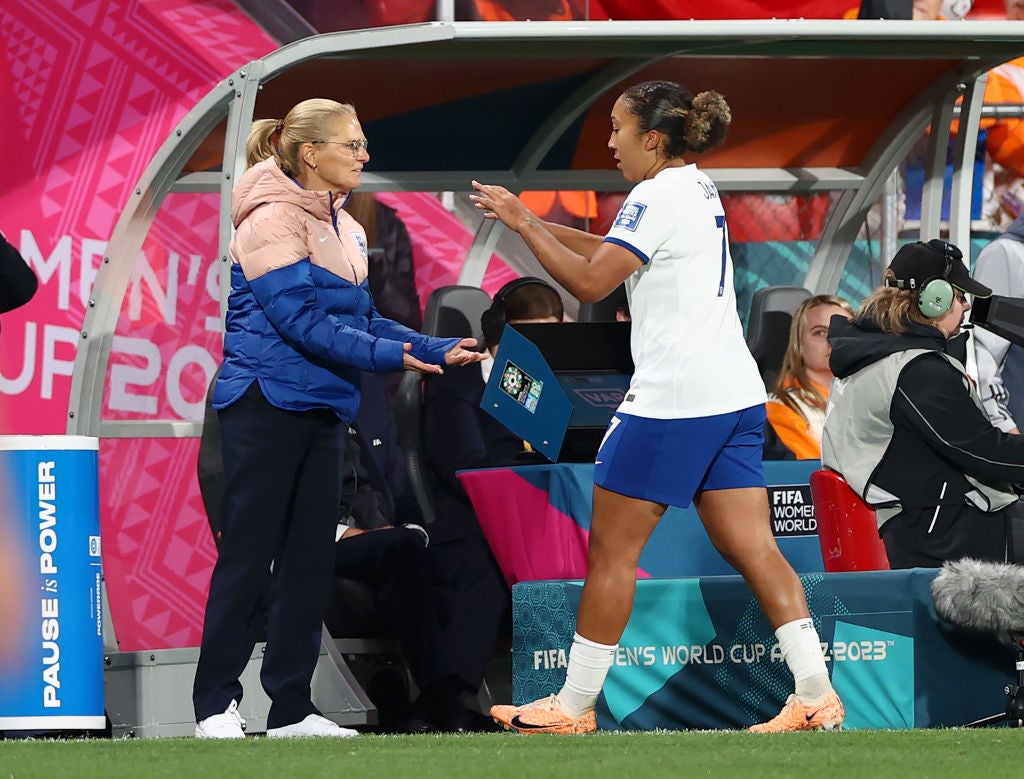Sarina Wiegman’s brave switch solves England’s Keira Walsh problem at Women’s World Cup
China 1-6 England: The Lionesses cruised into the knockout stages of the Women’s World Cup as a major tactical tweak sparked their best performance of the tournament

Your support helps us to tell the story
From reproductive rights to climate change to Big Tech, The Independent is on the ground when the story is developing. Whether it's investigating the financials of Elon Musk's pro-Trump PAC or producing our latest documentary, 'The A Word', which shines a light on the American women fighting for reproductive rights, we know how important it is to parse out the facts from the messaging.
At such a critical moment in US history, we need reporters on the ground. Your donation allows us to keep sending journalists to speak to both sides of the story.
The Independent is trusted by Americans across the entire political spectrum. And unlike many other quality news outlets, we choose not to lock Americans out of our reporting and analysis with paywalls. We believe quality journalism should be available to everyone, paid for by those who can afford it.
Your support makes all the difference.Rip it up and start again: if Keira Walsh’s injury spelled the end of something at the Women’s World Cup, it only did for England’s starting formation. Against China, Sarina Wiegman made her most dramatic change as Lionesses manager yet, switching to a 3-5-2 system to counter the blow of losing their key midfielder. In doing so, Wiegman created something new, unlocking England’s best performance in months.
The Lionesses looked like themselves again, and while England’s 6-1 win against China made sure of their progress to the last-16 as Group D winners, as much focus will be on how Wiegman has recalibrated and recharged her side ahead of the knockout stages. After two 1-0 wins over Haiti and Denmark there was an element of danger coming into the decider, but from the opening moments, the tempo and fluidity of England’s performance erased any doubts.
England have done so while veering drastically from the course they set at the Euros, where Wiegman named the same starting line-up in all six matches. But this is a new tournament and England are facing a very different challenge, which Wiegman has reacted to decisively. Wiegman could have chosen the easy option, to bring in Laura Coombs for Walsh and stick with England’s 4-3-3. Instead, Wiegman’s tweak has sparked England into life.
From looking slow and predictable in their opening game, England carried threat from all areas against China: Lucy Bronze and Rachel Daly, wing-backs who played as wingers, stretched China out of shape, allowing space for Alessia Russo and Lauren Hemp to create havoc down the channels. The back three of Jess Carter, Millie Bright and Alex Greenwood compensated for the loss of Walsh in England’s build-up play, with Georgia Stanway and Katie Zelem, starting for the first time at the World Cup, creating a box midfield in front.
It all unlocked room for Lauren James, who didn’t even start England’s opening game but is now so central to everything they do. To almost illustrate that, James was shifted inside to No 10, given the freedom to drift and pick up the ball where she could cause the most danger. James, who is quickly becoming England’s most important player at the World Cup, sparkled again, displaying the confidence of a player who knows she has been given the stage to become one of the stars of the tournament.
But, to do so, James also needs a structure that suits her and Wiegman has landed upon a formation and line-up that does that, not just for her, but for every other player in the team. Bright looked exposed in a back four when England faced transitions, but had excellent cover when alongside both Carter and Greenwood. Russo has gone from being isolated to having more options around her and the sheer speed of Hemp is now able to play off her shoulder. Stanway did not have sole responsibility to screen England’s defence, with Zelem providing balance alongside her.
Wiegman could not replace Walsh, but they could recreate her control. Even without their metronome, England still dominated the ball, particularly in the first half when the game was live and the Lionesses played at their highest intensity. To add to the possession, England’s shape gave them penetration and pace, with movement and rotation. The 3-5-2 seemed to give every player another option.

That isn’t to say this will be England’s plan for the rest of the tournament. From being able to predict Wiegman’s selection last summer, the Lionesses have shown they are prepared to change for their approach with the opposition in mind. China were a side who were always going to sit deep with two blocks of four, so England looked to pull them apart. It could be different against Nigeria in the last-16, given the threat of Asisat Oshoala and wingers like Uchenna Kanu who stay high and wide.
But from the blow of losing Walsh, England now have confidence that will elevate any system that Wiegman selects against Nigeria: Russo, Hemp, Daly and Chloe Kelly all scored, further lifting the mood in the camp and adding to several other impressive performances. World Cups and major tournaments are all about the journey – yet, even as the Lionesses comfortably progressed to the knockout stages as group winners, no one expected it to unfold quite like this, or is able to predict what comes next.



Join our commenting forum
Join thought-provoking conversations, follow other Independent readers and see their replies
Comments